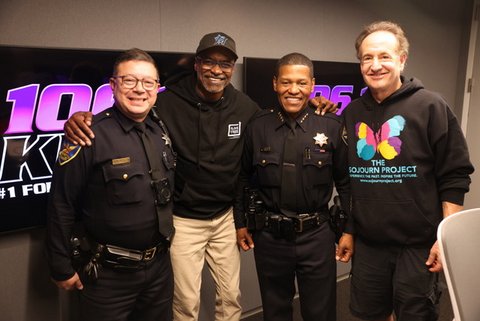
05 Aug EdSource: Newsom Directs Agencies to Tackle Loneliness Crisis Among Boys and Young Men

(Alison Yin / EdSource)
By Vani Sanganeria
EdSource
Top Takeaways
- The governor directed state agencies to expand access to mental health support and workforce opportunities.
- California’s college attendance rate among young men is 57%, compared to 68% for young women.
- Experts say early intervention and recruiting more men as teachers and counselors could address rising rates of suicide.
Gov. Gavin Newsom has ordered statewide agencies to expand access to mental health support, along with educational and workforce opportunities, in response to what experts say is a growing crisis of loneliness and depression among boys and young men.
Newsom’s executive order, issued last week, aims to address rising rates of suicide, unemployment and gaps in educational achievement for men in their 20s and early 30s in California.
“Too many young men and boys are suffering in silence — disconnected from community, opportunity, and even their own families,” said Newsom on Wednesday. “This action is about turning that around.”
The governor orders the California Health and Human Services Agency, alongside programs like the Children and Youth Behavioral Health Initiative, to “support the mental health and help-seeking behavior” of boys and men and improve access to services in schools and the behavioral health system.
The directive highlights ongoing early childhood interventions and integrated social and health services in community schools, but it does not include new funding or programming.
Work and education pathways
Low workforce participation and college attendance for men is a trend that has worsened over the last decade.
The college-going rate for young men who completed high school in California is 57%, compared to 68% for young women. Rates are even lower for some racial and ethnic groups — 49% for Black and Latino men, 40% for Indigenous men.
Labor force participation for men without college degrees is also at an all-time low: 1 in 9 men between 25 and 54 are neither employed nor looking for work.
Newsom references several programs in his executive order that tackle this, including the Master Plan for Career Education, a framework to ensure billions of dollars are spent correctly across a dizzying array of agencies under the banner of career education. The governor previously announced that $20 million will be available to support apprenticeships through the Master Plan.
California Volunteers and the Labor and Workforce Development Agency are also instructed to examine opportunities to increase participation from men.
A crisis of loneliness
Newsom attributes a trend of “disconnected youth,” who are neither in school nor in the workforce, to a growing “crisis of loneliness.” Nearly 1 in 4 men under 30 years old report having no close friends, and 42% of teenage boys report experiencing feelings of loneliness.
Evy Lowe, a social worker and senior director at the Child and Family Guidance Center, said that in recent years, most of the boys and young men she has worked with have become more anxious due to persistent loneliness and isolation from the Covid-19 pandemic. But in her 30 years of serving children and families, Lowe said that schools have also missed the nuances of behavior between boys and girls who need support.
“Boys tend to be diagnosed with acting out behaviors — like ADHD or oppositional defiance — and what’s missed is their depressive or anxiety behaviors,” Lowe said. “Our boys are sometimes labeled as ‘non-compliant’ versus needing support, and so they shut down because of low self-esteem, or they might act out in anger and frustration because of lack of coping skills, lack of understanding and lack of support.”
The executive order also directs the California Department of Education to identify ways to recruit more men as teachers and school counselors through a previous $1 billion investment in teacher workforce expansion. Only 23% of teachers and 23% of school counselors across the country are men, and many educators say male teachers and counselors can model healthy leadership and emotional support for boys.
“There’s just not a lot of examples in our society of men who are strong and can get things done, but also find some strength and vulnerability and can open up emotionally,” said Marlon Morgan, CEO of nonprofit Wellness Together and a former school counselor. “I’d like to see [the state] continue to invest in roles like wellness coaches and recruit more men, especially for our boys.”
As the only male school counselor in a Northern California district of 11,000 students, Morgan said he often led his school’s anger management group and met with boys struggling with anger or aggression. He’d teach them how to regulate “acting out” or “acting in” behaviors by talking about feelings of sadness or fear with each other. Early intervention, paired with peer support, helped prevent boys from resorting to violence or self-harm, he said, especially in contrast to detentions, suspensions or expulsions, which only further isolate those students.
“When you see a boy who’s disconnected, feels hopeless, helpless, and then starts to make a plan to act out that anger on someone,” Morgan said, “if that boy could have been deeply connected socially and felt the value in meaningful relationships, they would have been able to get some of that sadness out that eventually became anger.”
>>>From the Pulse Archives:
‘Closer and Closer to Losing Him Forever’: Hate Groups Prey on Young Men, Tear Families Apart<<<
Newsom’s order instructs state agencies to develop recommendations to support boys and young men, as well as those around them, affected by violence. In California, men aged 15 to 44 die by suicide at three to four times the rate of women, often by firearms. Almost half of female homicide victims are also killed by a current or former male intimate partner.
Research suggests that these cycles of violence can take root in early childhood or adolescence, when schools excessively punish boys for their behavior. Pre-school boys are 4.5 times more likely to be suspended than girls, and Black boys are three times more likely to be suspended or expelled than their white peers.
Punitive measures significantly increase the rate of school dropouts, juvenile incarceration and negative life outcomes for boys and young men. Schools with fewer support staff are also more likely to punish instead of provide mental health intervention, especially when boys exhibit stress responses that are mischaracterized as aggression.
“It’s easier for boys to feel like they are a problem than to consider that they might have a problem,” Morgan said.
Barriers to access
The executive order also directs the California Health and Human Services Agency to examine gender disparities. Boys and young men are far less likely to seek mental health treatment than girls and young women; of those, young Black men receive the least services, despite higher rates of depression and suicide.
“We appreciate Gov. Newsom’s recognition of the urgent mental health needs facing young men and boys, especially Black youth who are too often overlooked,” said Christopher Nellum, executive director of EdTrust-West. “With sustained investment in culturally affirming support, diverse educators, and broader pathways to success, California has a real opportunity to lead with equity-minded practices and accountability.”
For Angela Vázquez, advocacy director of mental health at The Children’s Partnership, the governor’s directive places a tall order on programs that may not be able to deliver sustainable mental health support to young men. Most one-time state investments, through the $4.7 billion Children and Youth Behavioral Health Initiative, for example, are set to expire in 2027.
>>>From the Pulse Archives:
Kids Continue to Suffer in Mental Health ‘Shadow Pandemic’<<<
Newly hired mental health clinicians and wellness coaches may be sustained by Medi-Cal reimbursement; however, most non-clinical programs like the Youth Mental Health Academy, which can promote social connection and peer support among boys, will likely come to an end.
“The vast majority of state resources associated with these initiatives are one-time funds that are nearly exhausted,” said Vázquez. “It remains to be seen where the long-term funding for these efforts, particularly for non-clinical youth development programs and community-defined practices, will be resourced from.”
While Proposition 1, a mental health and substance abuse treatment initiative that voters approved in 2024, preserves an estimated $318 million for youth-focused early intervention services, the state spends nearly all of its $6.4 billion revenue to treat adults experiencing severe mental and behavioral health disabilities. According to Vázquez, the executive order does little to prioritize prevention, such as classroom-based infant and early childhood mental health consultations, which significantly reduces preschool suspensions and risk of incarceration for young Black boys.
An analysis by Manatt Health estimates that federal cuts will cause roughly 151,000 children in the state to lose their Medi-Cal coverage — a significant source of funding for school-based mental health services — and boys and young men in California may further lose access to new or improved services without the state protecting access to health care.
“Drastic cuts to Medi-Cal, our state’s housing crisis, and violent immigration enforcement from the (Trump) administration threaten families from meeting their basic health and economic needs — which inevitably leads to a chronic stress response,” Vázquez said.
“Those interventions are of limited value if low-income children and families in California, the majority of whom are of color, cannot access those services in a timely manner,” she said.
EdSource reporter Emma Gallegos contributed to this report.






No Comments